Picture this: you just finished making your first DIY project, let’s say a floating shelf. It looks great, but there’s a problem, it’s kinda heavy. You know instinctively that the drywall isn’t going to hold the shelf plus everything you want to store on it, so you need to drill into a wall stud. Unless you’re living in an unfinished reno, your drywall is covering up your studs so it’s hard to tell exactly where they are.

Enter our hero, the stud finder! A stud finder is a crucial tool for anyone looking to spruce up their walls with furniture or decorations. In this article, we’ll give you a quick rundown on how stud finders work, the different types that are out there, and also our recommendations for the best ones.
By the end of this article you’ll be an expert on all studly matters, and will be able to answer the question of how it works, because you probably don’t even know exactly! Then you’ll be on your way finishing that project your significant other has been bugging you to finish for ages. Of course, that’s after you point it at yourself and say, “Well, I guess it works!” (duh, you stud).
Alright studs and studettes, it’s time to study some stud finders!
Types of Stud Finders and How They Work
There are two main types of stud finders that dominate the market: electric and magnetic. Newer ones also use a small radar system, which we’ll also go over.
Electric models can be a little confusing so we’ll try and explain it in layman’s terms. Technically what happens is that the electric sensor detects something called the relative permittivity, which you can think of as a sort of insulation value, 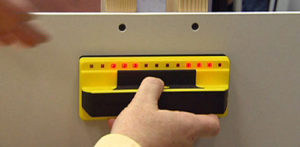 or how well electricity would pass through a specific material. When the stud finder is placed over plain drywall, the sensor detects a certain range of permittivity which the detector knows is drywall (no beep). But when you move it around your wall and over top of drywall with a piece of wood underneath, it detects a different relative permittivity, within the range that the tool knows is drywall+wood, which causes the tool to beep or light up.
or how well electricity would pass through a specific material. When the stud finder is placed over plain drywall, the sensor detects a certain range of permittivity which the detector knows is drywall (no beep). But when you move it around your wall and over top of drywall with a piece of wood underneath, it detects a different relative permittivity, within the range that the tool knows is drywall+wood, which causes the tool to beep or light up.
Magnetic sensors basically do what you think they would, and detect magnetic material – AKA metal. Most (probably all, but you never know) drywall is i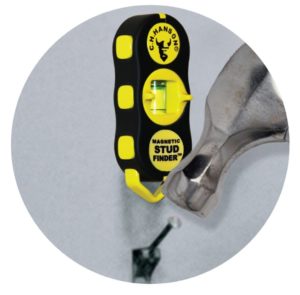 nstalled using small metal drywall screws, which is used to secure the drywall to the wooden struts. Then, it is covered up with compound to cover the screw holes and joints and eventually paint. But, a magnetic stud finder will detect the metal screws so you know where your stud is. Of course, this means you’ll need to trust that whoever installed the drywall actually did it properly and the screw is in a strut properly, but you should be fine in most cases. Of course, these are also useful for finding metal studs or pipes if that’s what you’re looking for.
nstalled using small metal drywall screws, which is used to secure the drywall to the wooden struts. Then, it is covered up with compound to cover the screw holes and joints and eventually paint. But, a magnetic stud finder will detect the metal screws so you know where your stud is. Of course, this means you’ll need to trust that whoever installed the drywall actually did it properly and the screw is in a strut properly, but you should be fine in most cases. Of course, these are also useful for finding metal studs or pipes if that’s what you’re looking for.
Radar detecting units are only just starting to become more popular as the technology becomes more affordable to produce and also shove inside a small enough unit to be useful. If you didn’t know, radar is actually an acronym RADAR, meaning RAdio Detection And Ranging. How it works is that a transmitter sends out many small pulses  of radio waves, that when they come in contact with a material that reflects radio waves (in this case wood, pipes, electric wire etc.) then it bounces back and into a receiver in the radar unit. The sensor detects the location, timing and other information of the reflect radio waves to tell you about what they came in contact with. This is the same technology they use in fish finders. In the case of a stud finder, it can provide a very accurate depiction of what’s laying under your walls. These units are still quite expensive however, but for professionals they are the preferred choice because of the accuracy they can provide.
of radio waves, that when they come in contact with a material that reflects radio waves (in this case wood, pipes, electric wire etc.) then it bounces back and into a receiver in the radar unit. The sensor detects the location, timing and other information of the reflect radio waves to tell you about what they came in contact with. This is the same technology they use in fish finders. In the case of a stud finder, it can provide a very accurate depiction of what’s laying under your walls. These units are still quite expensive however, but for professionals they are the preferred choice because of the accuracy they can provide.
Picking The Best Stud Finder of 2017
Now that you understand the difference between the three types of stud finders, we’re going to dive into our product reviews and find the best on for you. While other articles give you up to 12 reviews to read through, our team got together after a several hours of research and narrowed it down to just the best 3 to choose from, one of each kind: magnetic, electric and radar.
Bosch D-Tect150 Wallscanner (Radar)

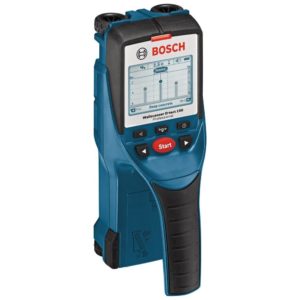
First on our list of recommended is the Bosch D-Tect150. This radar unit is the cream of the crop of stud finders, and the top choice for most professionals. It uses Bosch’s Ultra-Wide Band (UWB) radar, which paints a large picture of detection. This is perfect for situations like when you need to drill into concrete walls, but need to know if there are any metal or plastic pipes hidden within. It can work in 7 different material detecting modes: concrete, wet concrete, dry concrete, in-floor heating, drywall, metal and signal. Each mode contains specialized settings that give a more accurate depiction based on what substance you’re checking. It can detect wood and metal (like most other finders) but also plastic pipes and live wiring, making it a great choice for electricians, plumbers and contractors alike. And, it doesn’t just detect the material, but it will tell you how deep the materials are, and if they are either metal or not. It has a bright backlit display that will tell you the depth and location of the hidden objects, even if there is two close together. You can estimate the size of large plastic pipes even. It does have some limitations, with a max detection depth of 3-1/8″ for copper wire, and 1-1/2″ for wood studs, but these depths are more than enough for most uses. It’s also on the pricey side (more than a little), but if you are working a lot with concrete or brick, and need to know what’s hiding underneath this is a great choice. Read More Reviews
Pros: Great for working with concrete, brick walls, detecting plastic and metal pipes, copper wires, all-around use
Cons: Expensive (we warned you), and can’t give you exact depths, only estimations (it’s the best there is for now, though)
ProSensor Precision Stud Finder (Electric)

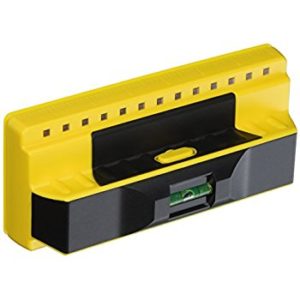
If a radar detecting unit is out of your budget (or work won’t pay for it) then you may opt for a more affordable electric or magnetic model. There are so many electric ones out there, it was tough to wade through them all, but we did it, and came out with this ProSensor at the top of the bunch. This is a simple, no-frills unit that just straight up gets the job done. It’s a wide L-shaped design, with bright red LEDs that span the entire width of the top. Not only does it tell you the location of a hidden strut, but the exact width as well, so you can make sure you hit exact center when you’re ready to drill. If an LED is illuminated, then you know there’s a stud underneath it, if they all are lit up, then you know you’ve got a really wide object hidden underneath the drywall. Here’s an example to help you picture it. A wall stud is typically 1.5″ wide, so three LEDs should light up for a typical strut. Any more than that may not be what you’re looking for. LEDs have a typical lifespan of around 50,000 hours, so it should last you quite a while. They’re also very efficient so your batteries (2x AAs) should last a long time as well. Of all the electric models we reviewed, this was the most reliable and accurate making it a great option for most folks. Read More Reviews
Pros: Shows width so easy to find center of studs, detects multiples at one time, should last several years
Cons: Requires batteries, doesn’t work great on tile or stucco
CH Hanson Stud Finder (Magnetic)

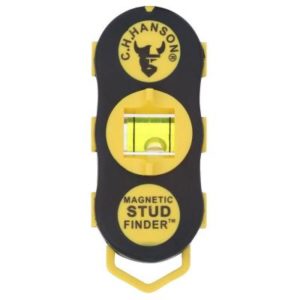
Our top pick for a magnetic one is this CH Hanson unit. This tool uses extremely strong rare-earth magnets to find the drywall screws hidden beneath your paint to detect where your wall struts are. The magnets are so powerful (and the unit small enough) that once you find a screw, the whole thing will just stick straight to the wall. Then you can take your hand off, and drill directly below or above straight into a stud. Because it is smaller, you may have to sweep the wall quite a bit before you find a screw. Once you do, you can estimate either 16″ or 24″ (two most commonly used distances) to find your next one. Because of the strong magnets, it will stick to your ladder making it easy access, and stick to your toolbox making it hard to misplace.It’s also got a small tubular spirit level included if you need to be doing any more accurate measuring. And, you don’t need batteries which is a huge plus over a radar or electric model. But, because it senses metal and not actual wood like a radar or electric, you could potentially be picking up on something else. You could also miss the strut if the drywaller missed the mark on their screw, or if they didn’t get hit exact center. It’s extremely affordable and easy to use, and not using batteries is pretty handy, despite the small amount of accuracy you’ll lose. Read More Reviews
Pros: No batteries required, lightweight, sticks to screws making it hands-free, built-in spirit level
Cons: Very small (~3″) and sensitive so you may need to swipe a lot to find a screw, detects metal and not wood, so you could pick up on something else, and doesn’t give you the exact width/center of strut
